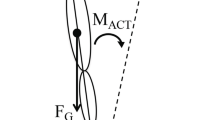Abstract
Healthy subjects performed bilateral fast shoulder movements in different directions while standing on a force platform. Anticipatory postural adjustments were seen as changes in the electrical activity of postural muscles as well as displacements of the center of pressure and center of gravity. Postural muscle pairs of agonist-antagonist commonly demonstrated triphasic patterns starting prior to the first electromyographic (EMG) burst in the prime-mover muscle. Proximal postural muscles demonstrated the largest anticipatory increase in the background activity during movements in one of the two opposite directions (forward or backwards). These changes progressively decreased when movements deviated from the preferred direction and frequently disappeared during movements in the opposite direction. The patterns in distal muscles varied across subjects and could demonstrate larger anticipatory changes during movements forward and backwards as compared to movements in intermediate directions. Bilateral addition of inertial loads to the wrists did not change the general anticipatory patterns, while making some of their features more pronounced. Anticipatory postural adjustments were followed by later changes in the activity of postural muscles, also reflected in the mechanical variables. Changes in leg joint angles revealed a „hip-ankle strategy” during shoulder flexions and an „ankle strategy” during shoulder extensions. The study demonstrates different behaviors of proximal and distal muscles during anticipatory postural adjustments in preparation for fast arm movements. We suggest that the proximal muscles produce a general pattern of postural adjustments, while distal muscles take care of fine adjustments that are more likely to vary across subjects.
Similar content being viewed by others

References
Allum JHJ, Honneger F, Pfaltz CR (1989) The role of stretch and vestibulospinal reflexes in the generation of human equilibrating reactions. Prog Brain Res 80:399–409
Belenkiy VY, Gurfinkel VS, Pal'tsev YI (1967) Elements of control of voluntary movements. Biofizika 10:135–141
Bernstein NA (1967) The co-ordination and regulation of movements. Pergamon, Oxford
Bouisset S, Zattara M (1987) Biomechanical study of the programming of anticipatory postural adjustments associated with voluntary movement. J. Biomech 20:735–742
Bouisset S, Zattara M (1990) Segmental movement as a perturbation to balance? Facts and concepts. In: Winters JM, Woo SLY (eds) Multiple muscle systems. Biomechanics and movement organization. Springer, Berlin, Heidelberg, New York, pp 498–506
Brown JE, Frank FS (1987) Influence of event anticipation of postural actions accompanying voluntary movement. Exp Brain Res 67:645–650
Buchanan TS, Almdale DPI, Lewis JL, Rymer WZ (1986) Characteristics of synergetic relations during isometric contractions of human elbow muscles. J Neurophysiol 56:1225–1241
Buchanan TS, Rovai GP, Rymer WZ (1989) Strategies for muscle activation during isometric torque generation at the human elbow. J. Neurophysiol 39:925–935
Corcos DM, Gottlieb GL, Latash ML, Almeida GL, Agarwal GC (1992) Electromechanical delay: an experimental artifact. J. Electromyogr Kinesiol 2:59–68
Cordo PJ, Nashner LM (1982) Properties of postural adjustments associated with rapid arm movements. J. Neurophysiol 47:287–302
Crenna P, Frigo C, Massion J, Pedotti A (1987) Forward and backward axial synergies in man. Exp Brain Res 65:538–548
Diener HC, Horak FB, Nashner LM (1988) Influence of stimulus parameters on human postural responses. J Neurophysiol 59:1888–1905
Dietz V, Horstmann GA, Trippel M, Gollhofer A (1989) Human postural reflexes and gravity-an underwater simulation. Neurosci Lett 106:350–355
Friedli WG, Cohen L, Hallett M, Stanhope S, Simon SR (1984) Postural adjustments associated with rapid voluntary arm movements. I. Electromyographic data. J Neurol Neurosurg Psychiatr 51:232–243
Friedli WG, Hallett M, Simon SR (1988) Postural adjustments associated with rapid voluntary arm movements. II. Biomechanical data. J Neurol Neurosurg Psychiatr 47:611–622
Gottlieb GL, Corcos DM, Agarwal GC (1989) Strategies for the control of voluntary movements with one mechanical degree of freedom. Behav Brain Sci 12:189–250
Hallett M, Shahani B, Young R (1975) EMG analysis of stereo-typed voluntary movements in man. J Neurol Neurosurg Psychiatr 38:1154–1162
Horak FB, Nashner LM (1986) Central program of postural movements: adaptation to altered support-surface configurations. J Neurophysiol 55:1369–1381
Horak FB, Nashner LM, Diener HC (1990) Postural strategies associated with somatosensory and vestibular loss. Exp Brain Res 82:167–177
Hugon M, Massion J, Wiesendanger M (1982) Anticipatory postural changes induced by active unloading and comparison with passive unloading in man. Pflugers Arch 393:292–296
Keshner EA, Woollacott MH, Debu B (1988) Neck and trunk muscle responses during postural perturbations in humans. Exp Brain Res 71:455–466
Latash ML, Aruin AS, Shapiro MB (1995) The relation between posture and movement: a study of a simple synergy in a twojoint task. Hum Move Sci (in press)
Lestienne F (1979) Effects of inertial loads and velocity on the braking process of voluntary limb movements, Exp Brain Res 35:407–418
Massion J (1992) Movement, posture and equilibrium: interaction and coordination. Prog Neurobiol 38:35–56
Moore SP, Rushmer DS, Windus SL, Nashner LM (1988) Human automatic postural responses: responses to horizontal perturbations of stance in multiple directions. Exp Brain Res 73:648–658
Mustard BE, Lee RG (1987) Relationship between EMG patterns and kinematic properties for flexion movements at the human wrist. Exp Brain Res 66:247–256
Nashner LM (1976) Adapting reflexes controlling human posture. Exp Brain Res 26:59–72
Nashner LM, Shupert CL, Horak FB, Black FO (1989) Organization of posture controls: an analysis of sensory and mechanical constraints. Prog Brain Res 80:411–418
Oddsson L (1989) Motor patterns of a fast voluntary postural task in man: trunk extension in standing. Acta Physiol Scand 136:47–58
Ramos CF, Stark LW (1990) Postural maintenance during movement: simulations of a two joint model. Biol Cybern 63:363–375
Rogers MW, Pai Y-C (1990) Dynamic transitions in stance support accompanying leg flexion movements in man. Exp Brain Res 81:398–402
Zattarat M, Bouisset S (1986) Chronometric analysis of the posturo-kinetic programming of the voluntary movement. J Mot Behav 18:215–223
Author information
Authors and Affiliations
Rights and permissions
About this article
Cite this article
Aruin, A.S., Latash, M.L. Directional specificity of postural muscles in feed-forward postural reactions during fast voluntary arm movements. Exp Brain Res 103, 323–332 (1995). https://doi.org/10.1007/BF00231718
Received:
Accepted:
Issue Date:
DOI: https://doi.org/10.1007/BF00231718



